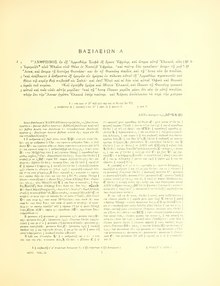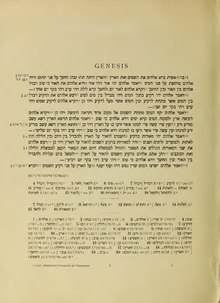Historical-critical edition
As a historical-critical edition (abbreviation TCA ) is known in the scholarly editing an output of a text that traces based on all text support available to the genesis of the text and an authentic as possible of errors presented adjusted text. In addition to the text indexing, such an edition offers a text-critical apparatus as well as documents on the history of origin, explanations and other aids. Due to the meticulousness and detail of the text indexing, it offers - in contrast to simple reading editions - a reliable basis for academic study of the text.
General
Historical-critical editions, especially total editions , are large-scale scientific projects that are very labor-intensive and costly, and in some cases stretch over decades. They are usually developed in universities , academies or archives and are publicly funded. Their main concern is to open up the work of an important thinker, writer or composer for research and to preserve it for posterity, or to document the tradition of an ancient work. Historical-critical complete editions are considered in the humanities as the " supreme discipline that brings dusty thoughts and forgotten connections to light".
The first historical-critical editions of the work in the narrower sense were in the 19th century; The Weimar Goethe edition, also known as the Sophien edition, is particularly influential . However, there have been forerunners since antiquity, primarily in Alexandrian philology (e.g. the Homer edition of Zenodotus of Ephesus ) and later in the exegesis of the Bible (e.g. the hexaplaric review of Origen ).
Why "historical"?
The historical attribute here means that all text carriers ( manuscripts , typescripts , prints ) that have come down to us are viewed and evaluated with regard to their role in the genesis of the text. From this, various processing stages can usually be reconstructed, which can be classified in the author's biography. However, not all text levels have to be printed in full. It is sufficient to select a version - (usually either the Editio princeps or the final edition ) - as a basis for comparison and to edit it as a reading text. The deviations of the other text levels are then documented in a text-critical apparatus. In addition to this, manuscripts (at least in excerpts) are often printed and / or transcribed as facsimiles . On the basis of the transcription , different processing stages within a text carrier can then be reconstructed and described from deletions, overwrites, insertions, the use of different writing implements etc. Thus, all of the material used for the edition is prepared and made accessible to the reader.
Why "critical"?
The critical attribute refers to the fact that the text carriers are not only printed, but also critically examined and evaluated. In the case of text variants, for example, a distinction must be made whether they are due to typographical errors in the manuscript, printing errors, revisions by the author or interventions by the editor. The question of authorization is often not easy to answer, especially with older texts. Detected errors are corrected by the editor; However, these corrections are usually not carried out in silence, but are documented in the apparatus. Sometimes errors are carried over from edition to edition over centuries and only corrected by a historical-critical edition.
In the case of variants between text carriers, the author's published versions must be distinguished from unpublished manuscripts or typescripts: Different published versions are to be regarded as having equal rights, even if usually only one is selected as the basis of the edited text. Manuscripts and typescripts are often more authentic because they are free from outside interference, but not intended for publication by the author and must therefore be assessed differently.
Types of historical-critical editions
In edition studies, a distinction is made between two types of historical-critical editions, depending on what is selected as the main text to be read.
Diplomatic text output
In a diplomatic text edition , an already existing text form is chosen for the main text, either because it can be traced back to the author himself as an autograph or final edition , or because it has established itself or is suitable as a standard text for other reasons. This can e.g. B. the text of the editio princeps or that of a particularly important manuscript. Examples in the area of biblical text editions are the Biblia Hebraica Quinta , which diplomatically reproduces the text and Masora of Codex L , and the large Cambridge edition of the Septuagint , which follows the Codex Vaticanus (B) in its main text and notes in the apparatus the different readings of the other text witnesses (see the adjacent figure). Deviating variants are only mentioned in the text-critical apparatus , even if the editors consider them to be “better” than the reading of the main text. "Diplomatic" in this context means that the editor remains faithful to the template he has chosen, but if there is room for interpretation, for example if the text is difficult to read, he tries to reproduce what would be expected in the template text. Diplomatic text editions are the rule for historical-critical editions of modern works, because an autograph, a first edition or a final edition is usually the main text.
Eclectic text output
In an eclectic text edition , the main text is specially created anew with the eclectic use of several witnesses. This procedure is useful if no complete witness has been preserved, as for example in the Gilgamesh epic , or if no single textual witness consistently offers the best tradition, e.g. B. because all full text witnesses are much younger than the attested literary work. The latter is the rule especially in works of ancient Greece and Latin, including the New Testament . Their historical-critical editions are therefore mostly eclectic text editions. Because it is unlikely that an editor will succeed in restoring the actual original text (“ Urtext ”) in all cases , the main text of such an eclectic edition is always a modern construction. Ideally, however, this construction is closer to the original text than the best of the ancient manuscripts. Examples in the area of biblical text editions are the Göttingen Septuagint , the editions of the Greek New Testament by Nestle and Aland and the von Gall edition of the Samaritan Pentateuch (see the illustration opposite). In an eclectic text edition, all text witnesses are treated in the same way, so that the readings of the most valuable text witnesses sometimes do not appear in the main text, but only in the apparatus.
Components
In addition to the text part, apparatus and the above information on text variants and error corrections, a historical-critical edition usually contains the following components:
- All received preliminary work for a work, for example notes, excerpts, schemes, etc. ( Paralipomena )
- Mention of the sources that the author used to write the work (possibly an excerpt from the sources)
- Documents on the genesis of the work (e.g. letters or diary entries from the author in which the work is mentioned)
- Explanation of the history of the impact of a work during the author's lifetime (e.g. based on reviews, sales figures, statements by contemporaries, etc.)
- Comments on payments in kind, outdated expressions, etc., which from today's perspective require comment
See also
literature
- Bodo Plachta: Edition Studies. An introduction to the method and practice of editing newer texts. Reclam, Stuttgart 1997, ISBN 3-15-017603-4 (UB 17603: Studies in literature)
Footnotes
- ↑ Alexander Cammann, in: Die Zeit from May 25, 2016, p. 46 (to complete the Georg Simmel Complete Edition in 24 volumes published by Otthein Rammstedt ).
- ^ Alan England Brooke, Norman McLean and Henry St. John Thackeray (eds.), The Old Testament in Greek according to the Text of the Codex Vaticanus, supplemented from other Uncial Manuscripts, with a Critical Apparatus containing the variants of the Chief Ancient Authorities for the Text of the Septuagint , three volumes, Cambridge 1909-1940.
- ↑ August von Gall , The Hebrew Pentateuch of the Samaritans , Giessen 1918.

